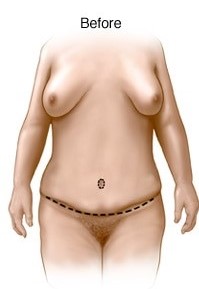Tummy tuck
Other terms: abdominoplasty, lipoabdominoplasty
Is surgical procedure to improve the appearance of the abdomen.
During a tummy tuck surgery, excess skin and fat are removed from the abdomen.
Loose skin and stretch marks below belly button are removed along with the skin.
Stretch marks above belly botton cannot be removed.
Muscles can be retightened for better contouring
You might choose to have a tummy tuck surgeon if you have skin that’s accumulated around the area of your bellybutton and a weak lower abdominal wall. A tummy tuck surgeon can also boost your body image.
You might consider a tummy tuck if:
- You have excess skin that’s accumulated around the area of your bellybutton
- You have a weak lower abdominal wall
- Liposuction didn’t adequately improve the appearance of your abdomen
- You previously had a C-section and have retracted scarring
A tummy tuck can also be done in combination with other body contouring cosmetic procedures, such as breast surgery.
A tummy tuck isn’t for everyone. Your doctor might caution against a tummy tuck
Risks
A tummy tuck poses various risks, including:
- Fluid accumulation beneath the skin (seroma). Drainage tubes left in place after surgery can help reduce the risk of seroma. Your doctor might also remove fluid after surgery using a needle and syringe.
- Poor wound healing. ..
- Tissue necrosis .
- Changes in skin sensation.
Like any other type of major surgery, a tummy tuck poses a risk of bleeding, infection and an adverse reaction to anesthesia.
How you prepare
- Review your medical
- Do a physical exam
- Discuss your expectations
Before a tummy tuck you might also need to:
- Stop smoking.
- Avoid certain medications
- Maintain a stable weight
- Arrange for help during recovery.
What you can expect
A tummy tuck is done in a hospital under general anesthesia
After the procedure
After a tummy tuck, your abdominal incision and your bellybutton will likely be covered with surgical dressing. Small tubes might be placed along the incision site to drain any excess blood or fluid.
. Drains might be left in place for several days after surgery. You might need to continue taking an antibiotic as long as the drains are in place. Your surgeon also might prescribe an anticoagulant for several days after your tummy tuck.
For the first six weeks after a tummy tuck, you’ll need to take care when moving and avoid positions that strain your incision line


Results
By removing excess skin and fat and restoring your abdominal wall, a tummy tuck can give your abdomen a more toned appearance.
Tummy tuck surgery results are usually long lasting. Keep in mind that maintaining a stable weight is crucial for retaining your results. Dr Lahouel is a best tummy tuck surgeon in Johannesburg. Consult now tummy tuck cost in Johannesburg.